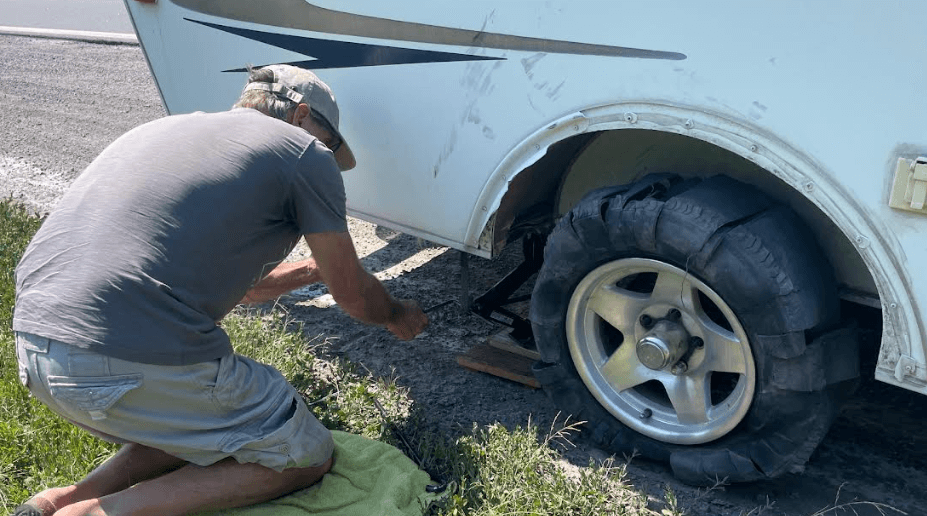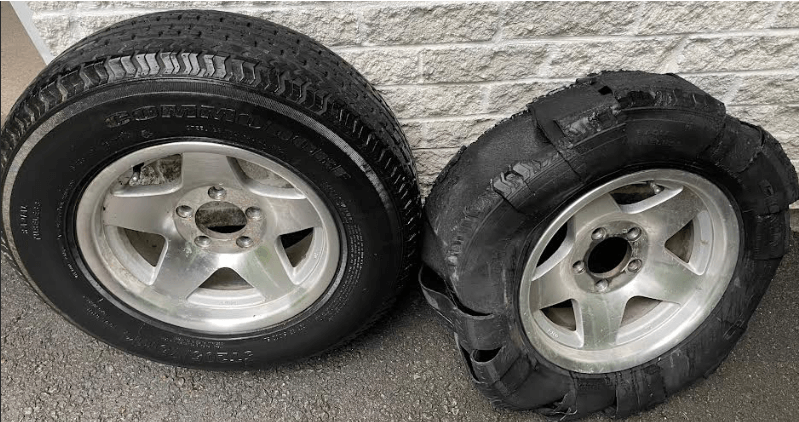While driving along Ontario’s Highway 401 in mid-July, I experienced something that many trailer owners dread—a sudden, explosive tire blowout. The right trailer tire let go with a deafening bang, shredding the trailer’s fender and damaging the wheel well. What surprised me most was how violent the failure was—it wasn't a slow deflation but a full-force rupture that could have led to a serious accident under different circumstances. If you look closely, you can see a big hole near the area being jacked and the white fiberglass wheel well is completely gone.

While some blowouts are "random" events that can't be predicted, in most cases there is some negligence involved, my case was no exception.
Trailer tire blowouts are more common than many realize and typically result from one or more of the following:
Aging tires: Rubber degrades over time, even if tread remains. Most trailer tires should be replaced every 5 to 7 years, regardless of visible wear. I think this is the main reason that my tire blew. These were the original tires and there was still plenty of tread left on them since I don't use the trailer very often. I realized after the blowout that the tires were almost 12 years old.
Heat: High temperatures soften the rubber and increase internal pressure. Combined with road friction, this can easily push old or weak tires past their breaking point. The outside temperature when the tire blew was 34C. Also, the sun was shining on the right side, further increasing the tire temperature.
Overloading: Exceeding a tire’s load rating puts undue stress on its internal structure. This can lead to bulging, separation, or full failure. I happened to be hauling about 100 pounds more than usual on the day my tire blew.
Underinflation: A tire that’s even 10% underinflated runs hotter and is more prone to blowouts. I don't think this was an issue since I had the tires inflated to the maximum 50 PSI pressure before the trip.
UV exposure: Tires exposed to constant sunlight (especially on one side of a parked trailer) deteriorate faster due to the breakdown of rubber compounds by UV rays. Although the tire that blew gets quite a bit of sunlight when the trailer is not in use, I usually have the tire protected by a tire cover.
Improper storage: Storing a trailer on bare ground or uneven surfaces can lead to dry rot, flat spots, and sidewall damage. This could have been a contributing factor as well.
Excessive Speed: I usually try to keep my speed under 100 km/hr when trailering but the speed limit at the time it blew was 110 km/hr so I did not want to drive under the speed limit. This higher speed would have also increased the tire temperature.
Stay calm and maintain control. Don’t slam on the brakes—gradually decelerate and pull off the road safely.
Inspect damage. Beyond the obvious tire replacement, check for:
Damage to the fender or body
Bent rims
Dislodged wiring or lights
Axle alignment issues
Replace the tire with the spare. Make sure your spare is inflated and not aged out.
Check the remaining tires. If one tire failed due to age or heat, the others may be at risk too.
Preventative maintenance and smart storage practices can significantly reduce the risk of tire failures:
Even if a tire looks fine, internal materials degrade over time. Check the DOT date code on the sidewall: the last four digits indicate the week and year of manufacture (e.g., "2318" = 23rd week of 2018). If they’re over 5 years old, start planning a replacement—especially before long trips.
Use a reliable tire gauge to check tire pressure before every trip, including the spare. When trailering, you usually want to fully inflate the tires to the maximum pressure indicated on the tire. Avoid “eyeballing” it, as underinflated tires can look fine until they fail.
Never exceed your trailer’s Gross Vehicle Weight Rating (GVWR) or the tire's maximum load capacity. Be aware that overloading one side—especially during uneven packing—can stress individual tires. Load as evenly as possible.
Look for spiderweb cracks in the sidewalls or between tread blocks. If you see these signs, replace the tire, regardless of tread depth.
Use tire covers or UV-blocking sprays to shield tires when the trailer is parked for long periods. If possible, rotate the trailer or swap the sun-exposed side periodically.
Use tire pads or blocks when parking for weeks or months. Dirt and asphalt can trap moisture or chemicals that degrade tires. Keep tires off the ground when storing long-term.
For peace of mind on the road, consider installing a TPMS specifically for trailers. These systems alert you in real-time if tire pressure drops or temperatures rise unexpectedly.
Many assume tire life is measured by tread wear—but trailer tires often age out long before they wear out. Tread depth is a poor indicator of tire health when it comes to age-related failures. As you can see in this photo; the mate of the tire that blew still looks pretty good. You can also see that all of the tread was completely blown off the failed tire.

The experience of a tire blowout was jarring and eye-opening. Thankfully, I was able to control the situation and avoid further damage or injury. But it was a clear reminder that trailers—especially older ones—need just as much attention to their tires as any vehicle on the road.
If you tow regularly, check your tires this week. If they're past their service life or showing signs of wear, it's better (and cheaper) to replace them now than deal with a roadside emergency later.
In my case, I was extremely lucky. I happened to be driving in the right lane, and I was very close to an on ramp, so I was not close to traffic when I swapped in my spare. Also, I was able to get over right away so there was no rim damage to my blown tire. The jack and tire iron from my car worked well in changing the trailer tire, however this may not always be the case. Be sure to check whether you need special tools for changing your trailer tires before your next journey.
Safe towing starts with good tires.